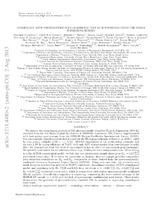| dc.contributor.author | Campbell, Heather | |
| dc.contributor.author | D’Andrea, Chris B. | |
| dc.contributor.author | Nichol, Robert C. | |
| dc.contributor.author | Sako, Masao | |
| dc.contributor.author | Smith, Mathew | |
| dc.date.accessioned | 2018-02-07T08:37:45Z | |
| dc.date.available | 2018-02-07T08:37:45Z | |
| dc.date.issued | 2013 | |
| dc.identifier.citation | Campbell, H. et al. (2013). Cosmology with photometrically classified type IA supernovae from the SDSS-II supernova survey. Astrophysical Journal Letters, 763(2): 88 | en_US |
| dc.identifier.issn | 2041-8205 | |
| dc.identifier.uri | http://dx.doi.org/10.1088/0004-637X/763/2/88 | |
| dc.identifier.uri | http://hdl.handle.net/10566/3482 | |
| dc.description.abstract | We present the cosmological analysis of 752 photometrically–classified Type Ia Supernovae (SNe Ia)
obtained from the full Sloan Digital Sky Survey II (SDSS-II) Supernova (SN) Survey, supplemented
with host–galaxy spectroscopy from the SDSS-III Baryon Oscillation Spectroscopic Survey (BOSS).
Our photometric–classificationmethod is based on the SN typing technique of Sako et al. (2011), aided
by host galaxy redshifts (0.05 < z < 0.55). SNANA simulations of our methodology estimate that
we have a SN Ia typing efficiency of 70.8%, with only 3.9% contamination from core-collapse (non-Ia)
SNe. We demonstrate that this level of contamination has no effect on our cosmological constraints.
We quantify and correct for our selection effects (e.g., Malmquist bias) using simulations. When fitting
to a flat _CDM cosmological model, we find that our photometric sample alone gives Ωm = 0.24+0.07/−0.05
(statistical errors only). If we relax the constraint on flatness, then our sample provides competitive
joint statistical constraints on Ωm and Ω∆, comparable to those derived from the spectroscopically-
confirmed three-year Supernova Legacy Survey (SNLS3). Using only our data, the statistics–only
result favors an accelerating universe at 99.96% confidence. Assuming a constant wCDM cosmological
model, and combining with H0, CMB and LRG data, we obtain w = −0.96+0.10/−0.10, Ωm = 0.29+0.02/−0.02 and Ωk = 0.00+0.03/−0.02 (statistical errors only), which is competitive with similar spectroscopically confirmed
SNe Ia analyses. Overall this comparison is reassuring, considering the lower redshift leverage of the
SDSS-II SN sample (z < 0.55) and the lack of spectroscopic confirmation used herein. These results
demonstrate the potential of photometrically–classified SNe Ia samples in improving cosmological
constraints. | en_US |
| dc.language.iso | en | en_US |
| dc.publisher | The American Astronomical Society | en_US |
| dc.rights | This is the pre-print version (From arXiv:1211.4480) of the article published online at: http://dx.doi.org/10.1088/0004-637X/763/2/88 | |
| dc.subject | Supernovae | en_US |
| dc.subject | General | en_US |
| dc.subject | Cosmology | en_US |
| dc.subject | Observations | en_US |
| dc.subject | Surveys | en_US |
| dc.subject | Distance scale | en_US |
| dc.title | Cosmology with photometrically classified type IA supernovae from the SDSS-II supernova survey | en_US |
| dc.type | Article | en_US |
| dc.privacy.showsubmitter | FALSE | |
| dc.status.ispeerreviewed | TRUE | |
| dc.description.accreditation | Web of Science | |

